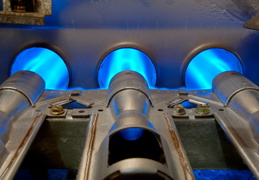
The short answer to this is, “it could be dangerous.” Give us a moment to elaborate on this.
We’re not surprised so many homeowners in our area choose a furnace for their heating needs. Gas furnaces are powerful and quite capable of keeping homes warm all winter long—no matter how brief and mild those winters usually are—this year has proven powerful heating systems are even more important!
Gas-powered heating systems are very cost efficient and make a great heating option for many reasons. However, like we said above, they can be dangerous. No gas-powered heater is inherently harmful, but if not cared for properly it could become so, risking carbon monoxide (CO) leaks and subsequent exposure.
This is more of a risk in an aging furnace, but can also happen in one with poor ventilation—read on to learn more!
What Does the Heat Exchanger Do?
In order to really understand why a cracked heat exchanger is such bad news, you should first understand what exactly a heat exchanger does. This component is tasked with actually heating the air that your blower fan sends through your ductwork system and then into your home. Essentially, the heat exchanger is the component responsible for safely providing your home with heat.
A heat exchanger is a clamshell-shaped metal chamber, and there is usually a series of them inside your furnace. The hot combustion gases from your furnace’s burner jets accumulates inside the heat exchangers, raising the temperature of the metal walls. This makes the outside of the heat exchangers very hot, and then the air blowing over them picks up that heat to carry it into your home.
This process prevents combustion gases, like CO, from coming into contact with your indoor air.
How Do Heat Exchangers Get Damaged?
The heat exchangers of your furnace go through a lot of strain every heating season. Every time they heat up, the metal expands. The metal contracts when they cool down, after your furnace cycles off. This constant expansion and contraction weakens the metal throughout the years, leading to eventual corrosion and cracked in the heat exchangers.
As we mentioned above, this is a more common problem in older furnaces. That is, furnaces that are 10-15+ years old. Cracked heat exchangers are also a problem in furnaces that are not properly vented. If your furnace was installed by an amateur, or if you have an older home and your furnace hasn’t been professionally inspected, this could be a problem you have and that you’re completely unaware of.
Why Cracked Heat Exchangers Are Bad News
It’s worth mentioning that a cracked heat exchanger is not something a homeowner can spot on their own, let alone repair on their own. These cracks are microscopic fissures, and they open up as the metal expands with heat, letting CO and other combustion gases out.
These gases can come into contact with your indoor air, leading to harmful exposure for you and your family. If you have an aging furnace, if your CO detectors have gone off, or if you hear clicking when your furnace cycles off (which can be the heat exchangers contracting as they cool down) it’s time to give us a call.
Contact Cool Care Heating and Air Conditioning for quality HVAC service in Houston, TX.
